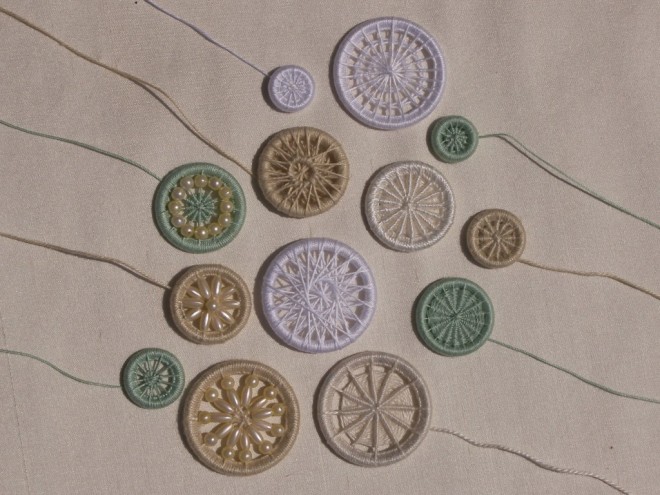After the last blog post and the comment by Sarah, I realized that I’d forgotten about Dorset Buttons. I tried to reblog the site I found about the buttons, but could not see a reblog button. There are two pages to visit at the site: 1. Look at all of the lovely variations here, and 2. Here are instructions on how to make a Dorset Button. They would make a lovely accent to hand knitted sweaters, hats, shawls, etc.
I’m intrigued by the fact that she used pearls in some of the buttons, I have never seen that variation. Being curious about the origins of the button, I found this info on Wikipedia (this isn’t serious, submit-a-paper research so Wiki is ok):
“A Dorset button is a style of craft-made button originating in the English county of Dorset. Their manufacture was at a peak between 1622 and 1850, after which they were overtaken by machine-made buttons from factories in the developing industries of Birmingham and other growing cities.
Types
Dorset buttons are characteristically made by repeatedly binding yarn over a disc or ring former.[1] There are three main forms and a large number of individual styles within these.
1. Wheels
‘Wheels’ are the most characteristic form of Dorset button. They are also known as Blandford Cartwheel, Crosswheels, Basket weave, Birds eye, Yarrell and Mites.[2]
Wheels are made by variations on the same processes of Casting, Slicking, Laying and Rounding:[3]
- Casting
- Blanket stitch is worked around a ring former, encasing it in a toroidal sleeve of yarn.[4]
- Slicking
- The initial stitches were worked from the outside of the ring. They initially protrude outside the ring, so they are now turned on the ring to all be on the inside.[4] This leaves the outer edge smooth, giving a more functional button, and also forms a slightly protruding flange of stitchwork on the inside.
- Laying
- Crosswise strands are stitched radially across the button, from side to side of the casting stitches.[4] Stitches are either caught through the casting stitches, now on the inside after slicking, or else they are simply wrapped over the outside of the ring.[4] These passes may form either a radial star or, if they pass to the sides of the centre, a hollow star. The number of strands varies for the pattern. Strands are usually arranged symmetrically around the ring, but they may be skipped or gathered into bunches, to give patterns.
- ‘Birds eye’ buttons do not have any laying or rounding, but use multiple passes of thickened casting to make a simple ‘doughnut’ button. Originally, before the introduction of wire rings, these were a single pass, formed over a rolled piece of cloth.[5]
- Rounding
- Rounding weaves a spiral of yarn over the crosswise laid strands, starting from the centre. This step gives most of the pattern variation for a wheel button. ‘Blandford Cartwheels’ may stop after only a few turns of rounding.[3] ‘Crosswheels’ have very little rounding and their cross strands are prominent. ‘Basket weave’ uses an extensive rounding, visible on the top surface and hiding the cross strands.
2. High Tops
‘High Tops’ or ‘Knobs’ are patterns that are taller, or nearly as tall, as they are wide.[2] They were the first Dorset buttons to be made, being made on a ram’s horn base, before the advent of the metal ring former. They are covered in fabric, then embroidered for decoration. [6] Techniques for making them were lost, but rediscovered in the 1970s. The Dorset Knob also gave its name to a locally produced hard biscuit.
3. Singletons
‘Singletons’ are made on a similar ring former to wheels, but this is padded with a disc of woven fabric that is then embroidered.[2] Their name derives from the Singleton family, who made a speciality of this style in the 17th century.[7][8]“



Actually, check out my blog and look at my dorset buttons on canvas and bracelet.
LikeLike
I just realized my gravatar leads to an older blog. Check-out my blog sticks-a-gogo.com for my dorset finery.
LikeLike
Q – Thank you for the new link. Just saw the update a few seconds ago. Will check out immediately!
LikeLike
I’ve never even heard of these! Thanks for the info–they’re gorgeous!
LikeLike
Q – Thank you! I found them while searching for something else. I just love them!
LikeLike